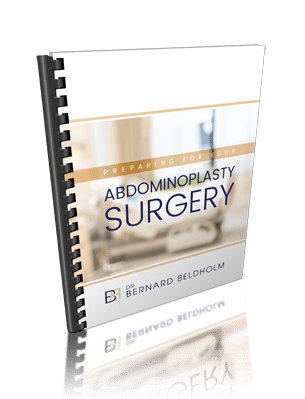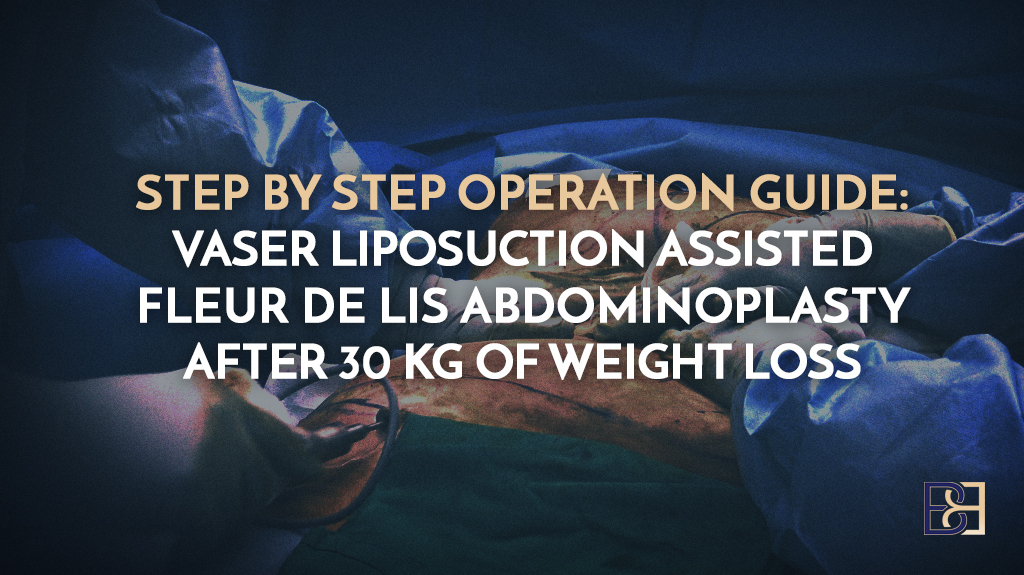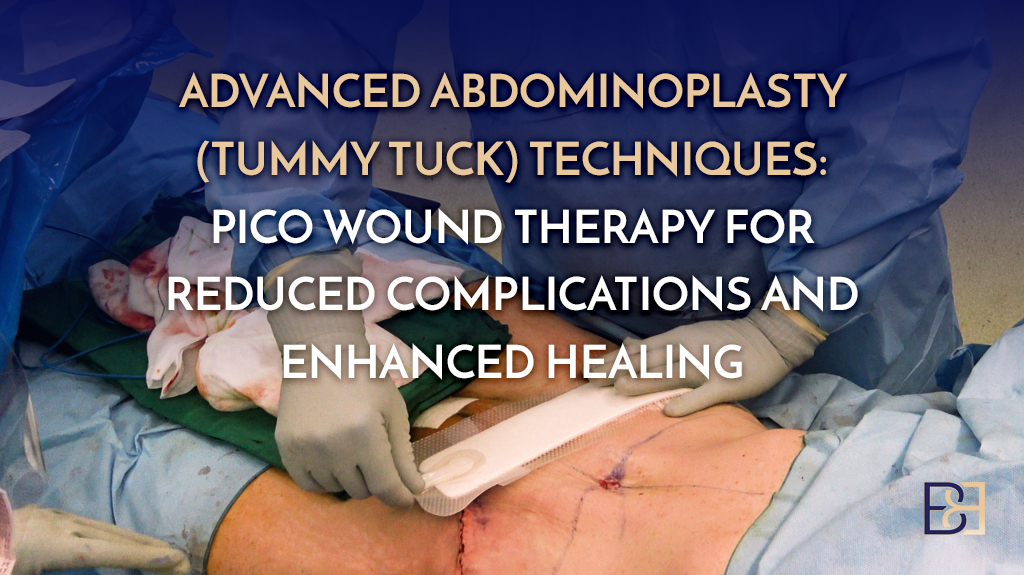Combining abdominoplasty with umbilicoplasty procedure tightens loose skin around the abdomen and reshapes the navel. Performed either as standalone procedures or in conjunction with one another, the goal of the two procedures is to create a smoother and a more aesthetically-pleasing abdomen.
Book your appointment online now
After pregnancy, every new mother wishes to get back to their old energetic self. However, pregnancy causes significant body changes, especially in the lower abdomen, that could be permanent. Apart from the loose hanging skin and excess fat, pregnancy can also affect the navel (AKA belly button or umbilicus), turning it from a vertically-shaped to a less appealing horizontal shape.
What Is an Umbilicus?

Caused by the detachment of the umbilical cord after birth, an Umbilicus, (commonly known as belly button or navel) is a remnant of the umbilical cord that connects an unborn child to the mother during the nine months of pregnancy, and is every human’s first scar.
Factors That Determine Umbilicus Appearance
Several factors, such as genetics, age, and weight, determine the appearance of the Umbilicus. For instance, family traits can influence the navel’s shape and size. Some people are simply predisposed to having an “innie” or “outie” belly button based on their genetic makeup. Additionally, the way the umbilical cord heals and the surrounding skin grows can lead to either a recessed innie or a protruding outie.

Some key genetic factors also influence umbilical appearance, including the umbilical hernia gene, skin and muscle development, and connective tissue strength. Moreover, the appearance of your Umbilicus may vary depending on age and BMI (body mass index). For instance, children tend to have their navel protruding outwards, and overweight people tend to have their Umbilicus appear deeper.
After significant weight loss, the drastic change in your abdominal contour can have an effect on the appearance of your navel.
Piercings on the navel can also affect its shape, size, and condition.

Pregnancy can also effectively alter the appearance of the belly button. Conditions that occur during or shortly after pregnancy, such as abdominal muscle separation, can also change the appearance of the Umbilicus. During delivery, an umbilical hernia, which involves fat tissues poking through the abdominal wall, can also impact the belly button’s appearance. In most cases, the Umbilicus reverts back to its original shape after childbirth, though it may appear slightly wider or less vertical in some women.
Umbilicus Aesthetics
The Umbilicus varies in shape and size; some people are content with their navel’s appearance, while others are not. The question is, what does the ideal Umbilicus look like?
A study by the National Library of Medicine shows that, “[o]ur findings revealed that an oval horizontal is the ideal umbilical shape in males, which differs from what is most aesthetically pleasing in females (oval vertical). In addition, we introduced the SHAPE (Shape, Hood, Adiposity, Protrusion & Position, External piercing) classification for navel appearance to better define the umbilicus and its direct management.”
This study shows that most people prefer an oval-shaped Umbilicus that doesn’t protrude outwards.
6 Umbilical Types
All placental mammals leave an umbilical scar after delivery. In humans, these visible scars come in different shapes and sizes, including these six distinct types:
Outie: Looks like a knot of skin protruding from the stomach
Horizontal: It appears like a horizontal dent in the belly
Vertical: A vertically oriented Umbilicus, often symmetrical from the top to bottom
Lightbulb: A vertically oriented Umbilicus that is wider at the top than the bottom
Oval/rounded: These Umbilicus are more circular compared to the rest
Deep: These form a funnel-shaped Umbilicus
How Pregnancy Affects the Umbilicus‘ Appearance
An Umbilicus changes are less pronounced during the first few weeks of pregnancy and might go unnoticed. As the uterus pushes up and your abdomen expands during pregnancy, changes in the appearance of the navel begin to become visible, with the most pronounced changes occurring during the second and third trimesters.
As the uterus expands, the navel begins to stretch and appear flattened or protrude outwards. This abdominal pressure pushes it out, turning it from an “innie” to an “outie.” A NLB (National Library of Medicine) study shows that, “[t]he uterus may be touched near the umbilicus by the 20th week, and the intrinsic growth practically stops [1]. The uterus expands more as a result of mechanical stretching of the muscle fibres and distension caused by the expanding foetus. The uterus reaches the costal edge at 36 weeks. To meet the growing needs, the uterine blood vessels also experience substantial hypertrophy [1].”
Though these changes can be significant, many mums do not notice them. Some expectant mothers report an uncomfortable or weird sensation, however, due to the sensitivity of the shifting navel. As pregnancy progresses and exposes the navel, some discomfort may be experienced as the Umbilicus begins to rub against clothing.
Book your appointment online now
How Childbirth Changes the Appearance of the Umbilicus
Childbirth can also affect your navel’s appearance.
Vaginal Delivery
In a vaginal delivery, abdominal stress can lead to diastasis recti (separation of abdominal muscles). This condition can alter the stomach’s appearance and may displace the belly button.

Another factor that changes the appearance of the Umbilicus is an umbilical hernia. An umbilical hernia occurs when part of the umbilical bulge through the opening in the abdominal muscles near the belly button (navel). In most cases, an umbilical hernia is painless and harmless, however, incarcerated or strangulated hernias require emergency repair. If the hernia is small and asymptomatic, however, it can be repaired following childbirth.
C-section
A caesarean section (C-section) can also have a noticeable impact on the appearance of the belly button. During this procedure, the incision is typically made just above the mons pubis, which can lead to changes in the umbilical shape and positioning. The belly button may appear slightly higher, elongated, uneven, and more asymmetrical than before. Over time, as the incision heals, the belly button may or may not return to its original shape.
Umbilicus Reconstructive Surgery
As the body recovers after pregnancy, the affected abdominal area tries to regain shape, and the navel can slowly return to its usual shape and position.
Sometimes, however, the umbilicus retains its stretched or unusual appearance, resulting in a permanently reshaped, distorted, or protruding state. This is where I come in.
If you are unhappy with the appearance of your umbilicus after pregnancy, surgery is an option.
There are basically two ways I perform umbilicus reconstruction: as a standalone procedure or incorporated into other body contouring surgeries, such as abdominoplasty. The ideal choice depends on the level of belly button displacement, as well as your preferences and expected goals.
These discussions will take place during our initial consultation session. The topics we will cover during the consultation will include everything from the various belly button reconstructive surgery options to the risks involved with these procedures. Furthermore, I will provide a comprehensive outline of your options based on your general health assessment and medical history.
Three Types of Umbilicus Reshaping
During our consultative session, we will discuss these three types of umbilicus reconstruction surgery in detail;
Umbilicoplasty procedures
Umbilical Hernia Repair
Abdominoplasty
These procedures vary depending on your preferences and level of umbilicus displacement. Umbilicoplasty surgeries are mostly minor surgeries that affect the tissue and skin around the belly button.
Umbilicoplasty
Umbilicoplasty is a cosmetic surgery that aims to alter your belly button’s appearance and position. The procedure involves using modern and advanced surgical techniques to correct a horizontal-shaped navel and give it a vertical shape look. An NLB study confirms that, “[u]mbilicoplasty in abdominal contouring procedures involves repositioning and insetting of the umbilicus following excision of excess skin and subcutaneous tissue with or without plication of the abdominal wall. ”
Note that an umbilicoplasty only reshapes the shape of your belly button and has no effect on any other abdominal part. Therefore, we will discuss the need to incorporate it into different surgical procedures, such as abdominoplasty or liposuction, as a post-pregnancy abdominal reconstruction procedure. During this conversation, we will also look into the associated risks, such as scarring and severe bleeding.
Benefits Of Umbilicoplasty
Umbilicoplasty aims to alter the navel’s shape and appearance. This procedure corrects extended or incorrectly positioned belly buttons and has the following benefits;
An unpleasant “outie” turns into an “innie”
Allows corrective belly button reshaping surgery done to remedy previous cosmetic procedures
Results in a better abdominal appearance
Indications for an Umbilicoplasty
The ideal patient profile for anyone looking to undergo an umbilicoplasty looks like this;
Is unhappy with their belly button’s appearance
Has an outie or pronounced button
Doesn’t smoke
Records a healthy weight record
Is in good health
Isn’t currently pregnant
Umbilical Hernia Repair
Umbilical hernia repair is ideal for cases where fat tissues poke through the abdominal wall, leading to an “outie.” In most cases, an umbilical hernia is painless and harmless. However, there are reports that it can be painful and result in health problems.
Apart from new mothers, umbilical hernia is very common in children. It starts as a soft swelling that can go unnoticed. During the first stages, it is visible when one coughs, cries, or strains.
Umbilical hernia can also affect adults who aren’t newborn mothers. Excess abdominal pressure is the leading cause of umbilical hernia for this patient profile. Other potential causes include obesity, fluid presence in your abdominal cavity, peritoneal dialysis, and previous tummy tuck surgery.
Abdominoplasty
While a standalone umbilicoplasty is possible, it is usually included as part of an abdominoplasty. This is a common choice for most of my patients, as it integrates belly button repositioning with removing excess skin and fat caused by pregnancy.
Abdominoplasty is a surgical procedure that targets skin laxity after pregnancy. The first part of the abdominoplasty involves freeing the umbilicus. The reason for moving the belly button is that when loose abdominal skin is cut away to create a smooth, flat tummy, the skin is pulled taut to close the incision. As the skin is pulled down, the belly button is pulled down as well. This makes it sit too low on the tummy, which looks unnatural. Therefore, I relocate the navel so that it sits in a natural position on the tummy.
As I conclude the abdominal surgery, I will stitch back your belly button, creating a neo-umbilicus (a new navel) that is more appealing.
For a step-by-step explanation of the operation, see my article Operation: Extended Abdominoplasty with Muscle Separation and Left Femoral Hernia Repair.
During my over 15 years of offering body contouring services, I have mastered the best techniques for recreating an oval /rounded belly button.
Not all abdominoplasty procedures involve belly button reshaping. For instance, a mini tummy tuck requires a small incision that runs along the bikini line, evading the belly button.
When Is It Appropriate to Undergo Umbilical Reshaping
During pregnancy and delivery, your body, especially the abdominal area, undergoes much strain, weakening muscles and tissues. As the uterus expands, it stretches and exposes these muscles. After pregnancy, the muscles should slowly begin returning to their normal position, and so does the navel. However, this might not be the case if you had a difficult delivery.
Whatever the case, it is crucial to give your body enough time to recover from pregnancy. I recommend waiting a minimum of twelve months before considering umbilicoplasty surgery. This duration is ideal for monitoring your body’s progress and seeing if it attempts to remedy the navel dispositioning.
Similarly, I advise you to wait for twelve months after pregnancy before considering an abdominoplasty. This allows the skin to return to its pre-pregnancy state. If you develop diastasis recti (separation of abdominal muscles) during pregnancy, this duration allows the muscles to heal and regain their previous shape. The twelve-month waiting period is an average estimate based on my experience; it may be shorter or longer, depending on your assessment results.
Incorporating Umbilicoplasty with Caesarean Section (C-Section)
Combining c-section and umbilicoplasty requires careful consideration. While it offers the convenience of combining both childbirth and cosmetic concerns in a single surgery, it also entails increased risks, such as infection and prolonged recovery. Again, the success of this surgery also depends on the patient’s overall health and ideal post-operative care. There are limited studies that suggest it can be done in select cases, however, I personally recommend separate procedures unless there is a compelling reason to combine them.
Risks of Belly Button Reshaping
Belly button reshaping has risks and complications, which include;
Infection
Skin hypertrophy
Umbilicus necrosis (death of the umbilical tissue)
Umbilical stenosis (narrowing of umbilical opening)
Skin colour changes (transient skin erythema)
Undesired results
Proper planning and heeding my advice can help reduce these risks. For instance, I advise against smoking six weeks before and after your surgery. I will make more recommendations during our consultation.
Recovery Time
Belly button reshaping recovery time differs between patients, but it can take a day to two weeks. If you undergo umbilical hernia repair, your recovery lasts two to six weeks.
During this time, following the post-surgery guide I’ll provide you is crucial to minimise potential risks and complications. Avoid straining your lower abdomen at all costs for better results.
Expect your reconstructed navel to retain its shape after surgery. There will be no significant changes in its shape or structure for over a year. After five years, you might notice a small, significant reduction in its size.
Note that you’ll only achieve these long-term results if you give your belly button enough time to heal after surgery.
What if I Get Pregnant Again?
There’s nothing wrong with getting pregnant again after an umbilicoplasty. However, as your uterus expands, it exerts pressure on the abdomen. If your abdominal muscles are weak, your new pregnancy might undo the results.
I advise you to wait at least a year after umbilicoplasty before getting pregnant again or wait to undergo the procedure once you’re finished having children.
My Bottom Line
Your priority after childbirth should be allowing your body to recover from the pregnancy and enjoying your new baby.
References
Graham, K. A., & Livingston, R. J. (2022). Ideal Male Umbilicus: An Observational Study of Surface Anatomy and Introduction to the SHAPE Classification. Aesthetic plastic surgery, 46(5), 2333–2341.
Dhamecha, R., Pajai, S., & Bhasin, T. (2023). Acute Abdomen in Pregnancy: A Comprehensive Review of Diagnosis and Management. Cureus, 15(6), e40679.
Hespe, G. E., Stepien, D. M., Sherif, R. D., & Gilman, R. H. (2021). Umbilicoplasty in Abdominoplasty: Modifications for Improved Aesthetic Results. Aesthetic surgery journal. Open forum, 3(3), ojab025
Kajikawa, A., Ueda, K., Katsuragi, Y., Kimura, S., & Hasegawa, A. (2012). How to reconstruct a natural and deep umbilicus: three methods of umbilicoplasty for five types of umbilical deformities. Annals of plastic surgery, 68(6), 610–615.
Henderson, J., Quiroga, L., & Gelman, J. (2023). Natural Umbilicoplasty Without Visible Scarring: An Easily Taught and Reproducible Technique. Aesthetic Surgery Journal. Open Forum, 5(Suppl 1), ojad027.017.
Gardani, M., Palli, D., Simonacci, F., Grieco, M. P., Bertozzi, N., & Raposio, E. (2019). Umbilical reconstruction: different techniques, a single aim. Acta bio-medica : Atenei Parmensis, 90(4), 504–509.
Baack, B. R., Anson, G., Nachbar, J. M., & White, D. J. (1996). Umbilicoplasty: the construction of a new umbilicus and correction of umbilical stenosis without external scars. Plastic and reconstructive surgery, 97(1), 227–232.
Ngaage, L. M., Kokosis, G., Kachniarz, B., Pedreira, R., Rada, E. M., Nam, A. J., Pearl, J., Kavic, S., & Rasko, Y. M. (2019). A Two-step Technique for Neo-umbilicoplasty in the Abdominal Reconstructive Population. Plastic and reconstructive surgery. Global open, 7(7), e2341.
Hespe, G. E., Stepien, D. M., Sherif, R. D., & Gilman, R. H. (2021). Umbilicoplasty in Abdominoplasty: Modifications for Improved Aesthetic Results. Aesthetic surgery journal. Open forum, 3(3), ojab025.
Kachare, S., Kapsalis, C., Kachare, M., Hiller, A., Abell, S., Lee, T. J., & Wilhelmi, B. J. (2019). Earplug Umbilicoplasty: A Simple Method to Prevent Umbilical Stenosis in a Tummy Tuck. Eplasty, 19, e12.
Çelik, V., Tuluy, Y., & Sır, E. (2023). Modified Diamond-Shaped Umbilicoplasty in Abdominoplasty. Aesthetic plastic surgery, 47(5), 1911–1919.
da Silva Júnior, V. V., & de Sousa, F. R. S. (2017). Improvement on the Neo-umbilicoplasty Technique and Review of the Literature. Aesthetic plastic surgery, 41 (3), 600–607.





